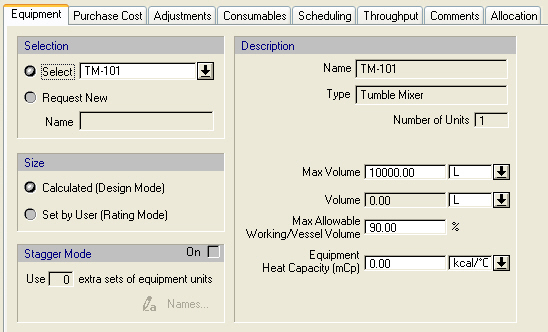

The following table shows the meaning of the variables appearing in this tab, as well as their default values and their generally acceptable range. Note that due to the manner by which the variables are used by the sizing and costing equations, the range of acceptable values may be further reduced.
|
Variable |
Default Value |
Range |
|
|
||
|
◙ Volume |
0.0 L |
Positive |
|
◙ Max Volume |
10,000 L |
Positive |
|
○ Max Allowable Working/Vessel Volume |
90% |
(0,100] |
|
○ Equipment Heat Capacity |
0 kcal/°C |
Positive. |
Symbol Key: ○ User-specified value (always input); ● Calculated value (always output); ◙ Sometimes input, sometimes output
In design mode, the user specifies the max volume, and the program calculates the number of units and volume based on the volume demand that is specified by the operations carried out as part of the (one or more) unit procedures hosted by the equipment resource. Typically, even during the span of a single procedure, more than one operations may demand different volumes. The software will size the vessel based on the largest demand on vessel volume amongst all operations executed in the vessel. If that volume exceeds the maximum volume specification then the software will assume multiple number of identical units, each with a volume that does not exceed the max volume specification, so that the total volume is equal to the demand.
For each operation, the operation’s demand on liquid volume is divided by the operation’s max allowable working to vessel volume ratio to determine the operation’s demand on vessel volume. The equipment’s max allowable working to vessel volume ratio acts as a constraint on the operation’s max allowable working to vessel volume ratio limits (i.e., the operation’s max working to vessel volume ratio limits must not exceed the equipment’s max working to vessel volume ratio).
For more information on the sizing of a Tumble Mixer, see Solids Mixing: Modeling Calculations.
In rating mode, the volume of the vessel and the number of units are provided by the user. As in the design mode case, the actual dimensions of each vessel (height and diameter) are calculated from the vessel volume and the height-diameter aspect ratio. The program also calculates exactly as in the design mode case the demand on vessel volume by the operations carried out as part of the unit procedure(s) hosted by the equipment resource, and if any the vessel volume demand of any operation exceeds the actual vessel volume, it generates a warning.
The equipment purchase cost supplied by the built-in model is zero, however the user may specify his own costing model if he wishes.
● Equipment Heat Capacity; the product of equipment mass times its specific heat capacity. It is used by operations that are executed in the vessel and involve heating and/or cooling. If part of the heat exchange is directed to the vessel, then this variable is used to estimate heating/cooling losses.
For more information on this equipment, see Tumble Mixer.
For information on the left-hand side variables and options, see Equipment Data Dialog: Equipment tab.